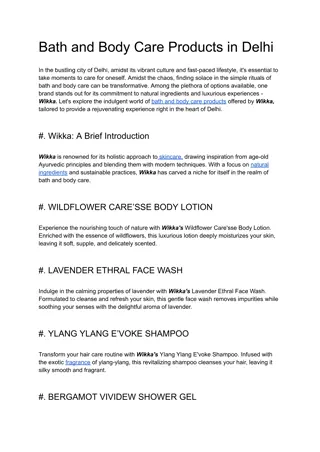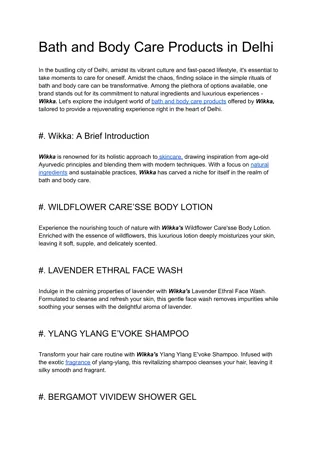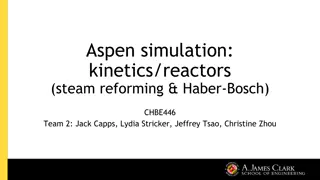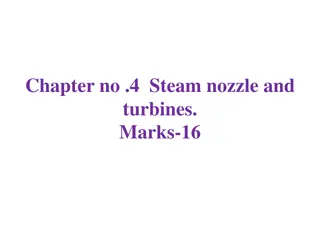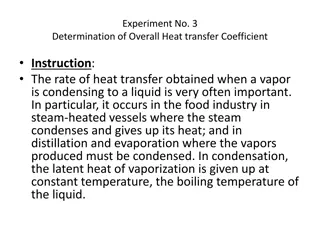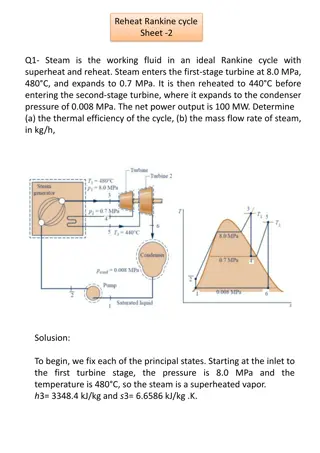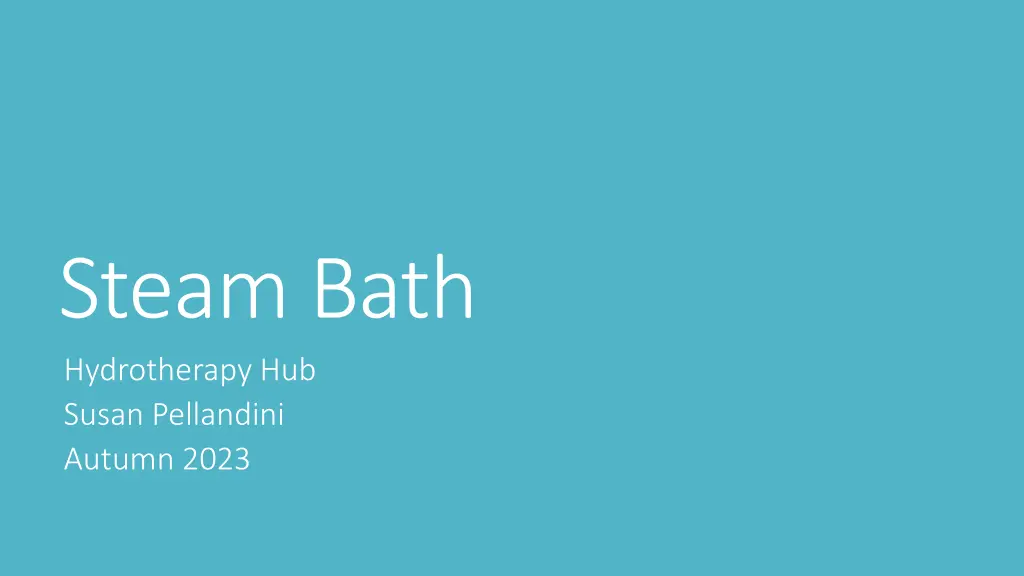
Steam Bath Hydrotherapy Benefits & Indications
Discover the therapeutic advantages of steam baths for health and well-being, including the physiological effects, indications, and safe practices to follow. Learn how steam baths can help with conditions like arthritis, gout, fibromyalgia, and sickle-cell anemia. Find out how to create a safe and effective steam bath experience at home or in professional settings.
Download Presentation

Please find below an Image/Link to download the presentation.
The content on the website is provided AS IS for your information and personal use only. It may not be sold, licensed, or shared on other websites without obtaining consent from the author. If you encounter any issues during the download, it is possible that the publisher has removed the file from their server.
You are allowed to download the files provided on this website for personal or commercial use, subject to the condition that they are used lawfully. All files are the property of their respective owners.
The content on the website is provided AS IS for your information and personal use only. It may not be sold, licensed, or shared on other websites without obtaining consent from the author.
E N D
Presentation Transcript
Steam Bath Hydrotherapy Hub Susan Pellandini Autumn 2023
Steam Bath Steam Bath Air and steam baths have been widely used for centuries to maintain health and treat dis-ease. People in various cultures flock to health clubs and wellness centers to utilize a dry sauna or steam room. Usually elaborate and expensive to heat and use, many cannot afford the benefits of these treatments. When tubs, showers and an abundance of running water are not available, a Steam Bath is an excellent whole-body heat treatment and can quickly warm the body. It can be utilized in any home setting with minimal but efficient equipment. Steam, as you recall is the most intense heat treatment; therefore, the body can heat more quickly. With the head outside of the enclosed steam bath and kept cool, a person can enjoy a deep heat treatment for arthritis, low back pain, recovery from repetitive-strain-injury or prevent an on-coming cold. Chiropractors, physical therapists and other therapists have used steam bath treatments as a means of perfect relaxation of muscles before massage and skeletal manipulative techniques.
Steam Bath Steam Bath MODULE OBJECTIVES After completing this module and After completing this module and Life and Health Hydrotherapy Videos Section 3.6 Life and Health Hydrotherapy Videos Section 3.6 the student will be able to: student will be able to: Describe the effects of the steam bath Describe the effects of the steam bath Explain the contraindications of the steam bath Explain the contraindications of the steam bath Explain conditions for which the steam bath is used Explain conditions for which the steam bath is used Be able to give a safe and effective Steam Bath Be able to give a safe and effective Steam Bath the
Steam Bath Steam Bath Definition An enclosure of 100% humidity, 105 130 F (40 54 C). The entire body is subjected to the condensing moisture except the head for the purpose of whole-body heating. https://www.amazon.com/Portable-Personal-Therapeutic-Weight- Indoor/dp/B07MS1B8YZ/ref=sr_1_10?crid=20X4WI9W3HEN2&keywords=steam%2Bcanopy&qid=1676 428517&sprefix=steam%2Bcanop%2Caps%2C108&sr=8-10&th=1
Steam Bath Steam Bath Physiological Effects 1. Hot moisture condenses on the skin. Because of the intense hot moisture heat is not lost through evaporation or sweating; therefore, the core body temperature can rise more quickly, the most unique effect of this treatment. 2. Increase of heart rate, respiratory rate and initial increase of blood pressure. 3. Increase immunity 4. Increase metabolism
Steam Bath Steam Bath Indications 1. Arthritis (Rheumatoid and osteo-) The intense, penetrating heat of steam is deep and therefore can be more relaxing and soothing. 2. Gout Relief from pain and inflammation in the feet and knee joints. 3. Fibromyalgia Same effect as with arthritis. 4. Sickle-cell anemia With intense vasodilation of blood vessels, red blood cells surge through the blood stream. Oxygen molecules ride on red blood cells, thereby combating sickle-cell anemia symptoms.
Steam Bath Steam Bath Indications, , continued 5. On-set of a cold, flu or full-blown symptoms With powerful vasodilation, white blood cells, natural killer T cells surge through the blood stream and engulf pathogens. 6. Prep for cold treatment procedures 7. Detoxification The steam bath induces intense sweating, therefore, toxins can be released readily. Using white towels to absorb the sweat allows one to see the various colors of toxins; from brown and yellow to gray and green. 8. General relaxation The deep, penetrating heat induces complete relaxation. continued
Steam Bath Steam Bath Indications, , continued 9. Musculoskeletal pain (including chronic low back pain, sciatica) 10.Fracture sites after cast has been removed continued
Steam Bath Steam Bath Cautions 1. Early Diabetes (no more than 10 minutes) 2. Recent meal (wait at least 1 hour) 3. Hypothyroidism Individuals with low thyroid function already tend for feel sluggish. A steam bath too often can encourage a depressing effect.
Steam Bath Steam Bath Contraindications 1. Advanced diabetes Most often, diabetics, especially insulin-dependent have arterial disease and blood insufficiency in the extremities. Skin capillaries do not dilate well, which means lower oxygen levels to metabolize heated tissue. The increased metabolic needs of warmed tissues quickly use up any nutrients and oxygen available in the blood. Therefore, cells can die because of not enough oxygen. 2. Congestive Heart Failure 3. Loss of skin sensation 4. Recent stroke, heart attack, major surgeries
Steam Bath Steam Bath Contraindications, continued 5. Extreme obesity 6. Under the influence of alcohol or street drugs 7. Lymphedema 8. Multiple sclerosis (leads to more fatigue) 9. Seizure disorders
Steam Bath Steam Bath Contraindications, , continued 10.Moderate-high Hypertension 11.Advanced arteriosclerosis (hardening of the arteries) As heat causes vasodilation of blood vessels, sclerotic vessels are unable to expand 12.Pregnancy Whole-body steam heat is too intense for the developing fetus. 13.Unconsciousness (while this might seem obvious, someone has tried it and so it must be included in the list )
Steam Bath Steam Bath Equipment (have all ready ahead of time) 1. Basin for hot foot bath (101 104 F / 38 40 C) 2. Chair (plastic preferred no metal or cloth upholstery) 3. Basin for cold water 4. Ice for cold water 5. 3 hand towels (for cold compress to head/neck) 6. 4 large bath towels 7. Heat source (hot plate with pot of water, rice cooker or skillet with water)
Steam Bath Steam Bath Equipment, continued 8. Glass of water & drinking straw 9. Thermometer 10.Large sheet & blanket or plastic tarp 11.Extension cord 12.BP monitor, health history form, treatment form 13.Prayer 14.Time device
Steam Bath Steam Bath Procedure 1. Heat water in heat source that will produce steam and place under chair. 2. Place 1 large towel on chair with part of it draping down in front 3. Place large towel on floor in front of chair 4. Explain treatment to client and clear for precautions. Be sure client has eaten within 2-4 hours. 5. Have subject void in restroom. 6. Take vital signs. 7. Pray for God s healing blessing. 8. Have client sit on chair with feet in hot foot bath (clothing & jewelry removed except underwear or swimwear).
Steam Bath Steam Bath Procedure, continued 9. Drape sheet & blanket or plastic tarp around subject. Be sure linens are not in heat source 10. Wrap a towel around neck to protect face from steam 11. Keep neck and head cool with towels or washcloths from ice water basin every 1-2 minutes. 12. Monitor pulse at carotid artery in neck. Do not exceed 120 bpm. 13. Give subject water to drink periodically 14. Duration: 7 10 minutes for tonic/stimulating effect 15 20 minutes for sedative effect Note: Note: Have an ice bag inside a pillow case ready to apply over client s heart if need be.
Steam Bath Steam Bath Procedure, continued 15. Remove heat source and hot foot bath. 16. Immediate cold shower for 30 60 seconds or full-body cold-friction in turn: feet in cold water basin for 30 seconds Friction legs up to groin (meanwhile, subject frictions chest/abdomen) Friction arms to armpits, hands Friction back (subject cools face if need be) 17. Subject dries thoroughly with dry towel 18. Dress immediately, including feet 19. Subject rests for 30 minutes undistracted and covered. (If subject sweats during rest, take 1 minute tepid shower. Dry immediately and thoroughly & dress.) 20. Retake vital signs and record treatment
Heat exhaustion / Brain overheating Heat exhaustion / Brain overheating Signs that brain is overheating: that brain is overheating: - Pallor (paleness) - Body temp. over 104 F (40 C) - Rapid, weak heart rate - Subject looks confused - Subject looks like they have difficulty breathing - Loss of coordination - Heavy sweating Symptoms of brain overheating: of brain overheating: - Rapid heart rate - Dizziness - Light-headedness - Nausea - Confusion - Difficulty breathing - Muscle cramps - Seizures
Treating Heat Exhaustion Treating Heat Exhaustion 1. Stop treatment immediately and cool subject 2. Have subject drink cool, room temperature water 3. Keep in supine position 4. Be sure room has good ventilation 5. Keep cool compresses on forehead, around neck and on heart area 6. Monitor vital signs.
STORY Rescue Worker Benefits From Sauna Treatments Background In 2001, 33-year-old Sean Donahue (real name used with permission) was a captain in the New York State National Guard. Sean, a Blackhawk helicopter pilot, was a healthy, highly conditioned athlete who worked as a computer consultant in lower Manhattan. On September 11, 2001, he was working just one block form the World Trade Center when he heard of the catastrophe. He hurried there, arriving just as the building s towers went down. He spent the rest of the day and the next performing search and rescue at the site, engulfed in deep smoke and airborne soot made up of such toxic substances as burning jet and diesel fuel, asbestos, benzene, dioxins, mercury, lead, manganese, polychlorinated biphenyls (PCBs)fiberglass, silicon, and sulfuric acid. He wore no special protective clothing except a simple dust mask some of the time. He began to have breathing difficulties on that first day but continued with the rescue work for 2 full days. He then returned to his work as a computer consultant. As he walked many blocks every day to his job, he continued to breathe in highly toxic materials from the cloud of tiny particles hat had settled over lower Manhattan. Even the air inside his office was foul with soot.
On September 16, severe respiratory distress forced him to visit a local hospital, where he had to be intubated or he would have died. Sean gradually developed a variety of health problems, including shortness of breath, chronic cough (the most common health complaint of rescue personnel), sinus pain, severe stomach and chest pain, chronic nausea, vomiting, diarrhea, skin rashes, flashbacks, and inability to concentrate. Finally, in March 2003 (18 months after his initial exposure), Donahue had a physical and was found unfit to pilot an aircraft. By January 2004, he was taking 10 medications without any noticeable improvement and was considering taking whole-body steroids as a last resort. Concerned about side effects, however, he opted to begin the program offered by the New York City Rescue Workers Detoxification Project.
Treatment Designed to help rescue workers (including police, fire, and medical personnel) excrete the toxins they absorbed, the detoxification program combined prolonged sweating in a sauna with nutritional supplements that support detoxification. For 33 days, Sean followed the same routine: vigorous exercise followed by a 140 180 F sauna bath for 2 to 5 hours, with frequent breaks to shower and rehydrate. (Detox personnel monitored all participant for heat exhaustion and dehydration.) At first, he felt no major difference. Although he never observed any highly colored sweat (many rescue workers have had purple, orange, gray, blue, or black seat), he did notice that his sweat had a very strong odor. Then, after 8 or 9 days on the program, he noticed a dramatic improvement in how he felt. His symptoms slowly began to decrease, and although at the beginning of the detoxification he could not even walk up a flight of stairs, a few weeks later he could run 3 miles. His chronic cough disappeared, and he was able to discontinue his medications. (S. Donahue, personal communication, October 10, 2006). Nothing else about Donahue s medial treatment changed during the detoxification program.
Today, Sean has not only returned to active duty, he has no health problems, takes no medications, runs miles every day, and is again approved to pilot aircraft. He has gone on to serve in combat zones in Afghanistan and Iraq and to assist in the recovery efforts in New Orleans after Hurricane Katrina. References 1. Cecchini M, Root D, Rachunow J, Gelb P. Chemical exposures at the World Trade Center: Use of the Hubbard sauna detoxification regimen to improve the health status of New Yor City rescue workers exposed to toxicants. Townsend Letter for Doctors and Patients, 2006; April :58. 2. Donahue S. Testimony before New York City Council, found on Web site of New York City Rescue Workers Detoxification Project. www.nydetox.org/results3.htm. Accessed November 2006. 3. Root D. Downtown Medial: A detox program for World Trade Center responders. Fire Engineering 2003; June:12
References References Sinclair, Marybetts, Modern Hydrotherapy for the Massage Therapist, Chapter 8, Lippincott Williams & Wilkins, 2008 Thrash A. Home Remedies: Hydrotherapy, Massage, Charcoal and Other Simple Treatments. Seale, AL: Thrash, 1981
End Presentation End Presentation


